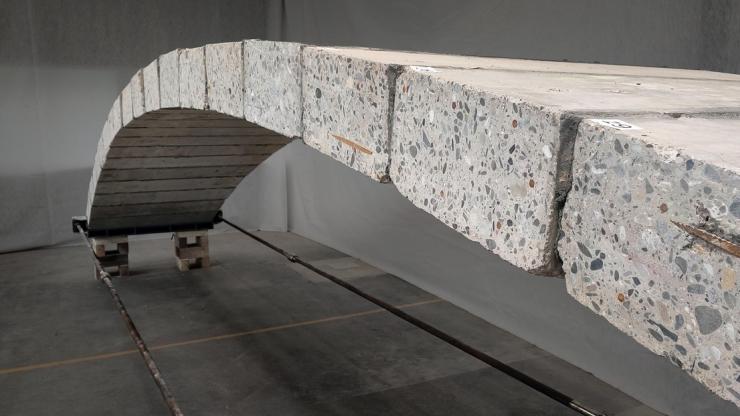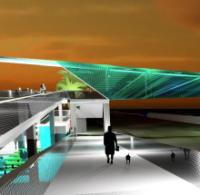The blocks were cut into individual pieces on site and assembled into a prestressed arch.

The project is part of an initiative to reduce construction’s carbon footprint by adopting a ‘circular economy’ approach.
The footbridge is being inaugurated today (11th October) at a ceremony at the Smart Living Lab in Fribourg.
“People are hesitant to reuse concrete due to a variety of concerns,” says Corentin Fivet, an assistant professor at EPFL and head of the Structural Exploration Lab (SXL) within the Smart Living Lab. “But we wanted to show that those concerns are largely unfounded. Blocks of concrete that are selected for reuse are just as reliable and useful as new blocks.”
Fivet has been studying potential applications of the circular economy in the construction industry for years. This project involved building a 10m-wide footbridge out of 25 blocks of concrete taken from walls destined to be torn down. The project engineers have now finished load-testing the new structure.
Jan Brütting, a recent PhD graduate from SXL who initiated this project, conducted the research as part of his postdoc along with fellow EPFL postdoc Maléna Bastien Masse. The team said that, for concrete to be reused effectively, new design methods are needed that are based on exploiting existing concrete sections, rather than the conventional approach of pouring fresh concrete in line with each project’s specifications.
The catch is that the properties of existing sections can vary and are not always known ahead of time. To help engineers employ these new methods, SXL has developed a computer program that automates the process of selecting reclaimed elements from a given stock and minimises a new structure’s carbon footprint.
In practice, builders are often reluctant to reuse concrete due to the perceived additional risk. But the SXL team believes there are only benefits to be had. “We gave ourselves two months to find a source building in the region and a demolition company that would be interested in working with us,” says Bastien Masse. That company turned out to be Diamcoupe, which had been commissioned to renovate a building erected less than 10 years ago; this renovation site was the perfect opportunity to source viable blocks of concrete. “We asked Diamcoupe to cut the concrete into the sizes we needed and to drill holes through them for our prestressing cables. These cables were provided by Freyssinet and used to build the arch,” she added.
The engineers were thus able to obtain 200mm-thick concrete blocks for the footbridge. They added mortar in places to smooth out the slight differences in dimensions, which are inevitable anytime objects are reused. “Arches are actually the ideal structure for repurposing concrete blocks, since the material is only subject to compression forces,” says Brütting.
Fivet said: “Most buildings in Switzerland are made out of concrete, and producing this raw material accounts for 7% of CO2 emissions from anthropogenic activity. What’s more, concrete makes up 50% of demolition waste. When the material reaches its end of life, it’s at best broken down into gravel or granulate to create recycled forms – but that consumes a lot of energy. If we were instead to cut up concrete blocks and reuse them, we could both prevent the need to produce more concrete and eliminate the inert waste. The carbon emissions from this process wouldn’t necessarily be zero, but they would be drastically reduced. We would delay the need to downcycle obsolete concrete.”
The SXL team said that its project is a call to action for the construction industry. “No other new concrete footbridge has a carbon footprint as small as ours,” says Fivet. “Imagine if every obsolete concrete structure out there was cut into blocks and used to meet some of the global demand for new concrete. That would be a big step towards addressing some of the most pressing climate-change challenges.”



